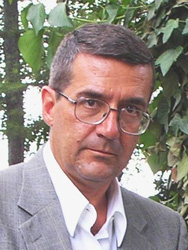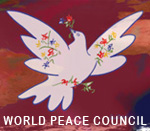“Srebrenica” as Holocaust: Trifkovic, the “Genocide Denier” - by Srdja Trifkovic
| Activities - Comments |
by Srdja Trifkovic • April 27, 2012 •
 In the latest issue of The Jewish Chronicle (UK) a polemicist by the name of Oliver Kamm takes The Jerusalem Post to task for publishing an article last February “by one Srdja Trifkovic claiming that US recognition of Kosovo was an advance for jihadism.” In a fact-free diatribe Kamm complains that the JP “did not mention that Trifkovic has described Srebrenica as ‘a myth based on a lie,’ the number of whose victims ‘remain[s] unknown and misrepresented’,” and adds:
In the latest issue of The Jewish Chronicle (UK) a polemicist by the name of Oliver Kamm takes The Jerusalem Post to task for publishing an article last February “by one Srdja Trifkovic claiming that US recognition of Kosovo was an advance for jihadism.” In a fact-free diatribe Kamm complains that the JP “did not mention that Trifkovic has described Srebrenica as ‘a myth based on a lie,’ the number of whose victims ‘remain[s] unknown and misrepresented’,” and adds:
To paraphrase the late Christopher Hitchens: it’s impossible to eat enough in order to vomit enough on reading such material. The Muslim populations of Bosnia and Kosovo bear as much relation to al-Qaeda as the Archbishop of Canterbury does to the snake-handling sects of Appalachia. Milosevic’s victims should be remembered. The truth about their fate should be defended.
“It is not just the equivalent of Holocaust denial,” Kamm goes on, “but the same fraudulent argument. It should be recognised and named for what it is: genocide denial.”
BEFORE WE REVISIT “Srebrenica,” let us deal briefly with Kamm’s interesting contention that the Muslims of Bosnia and Kosovo are immune to the well-known pursuits and obsessions of their coreligionists around the world.
“Frankfurt airport gunman jailed for life,” reported the BBC (among many others) on February 10. “A young Kosovan man who admitted shooting dead two US airmen at Frankfurt airport last year has been sentenced to life in prison,” the story went:
Arid Uka, now 22, is a Muslim ethnic Albanian who was born in Kosovo but grew up in Germany. Uka was convicted on two counts of murder and three of attempted murder by the court in Frankfurt. The American servicemen were travelling from the UK to the Ramstein airbase near Frankfurt… Two other airmen were seriously injured in the attack on a bus at the airport. A jammed gun prevented Uka from shooting a fifth airman in the head.
“Sarajevo gunman fires at US embassy in Bosnia capital,” the same source reported on October 28 of last year. After a standoff in the city centre, a police sniper wounded the 23-year-old Mevlid Jasarevic, a member of the Wahhabi sect, and he was arrested. Jasarevic spent an amazing 50 (fifty) minutes emptying frames of ammunition from his Kalashnikov at the embassy before he was wounded and apprehended. Earlier this week, on April 23, he and his two accomplices, Emrah Fojnica and Munib Ahmetspahic, were accused of forming a terrorist group in the Bosnian-Muslim village of Gornja Maoca. Jasarevic talked about his motives in a video taped just before the attack: “I don’t need to explain why I attack Americans,” said the bearded man, sitting with two automatic rifles leaning against the wall behind him. “They have launched a fight against Islam and Muslims across the whole world. They kill Muslims, rape their wives, take away the old and the young, arrest, do whatever they want.”
A former MI6 man who spent considerable time in Bosnia after the war told Balkanalysis.com that the delayed Bosnian police reaction—and the fact that security lapses allowed the attack to happen in the first place—came as further confirmation that “the Bosnians are just not reliable partners. We’ve seen them befriending the Saudis, but also others if it suits [their interests]. Bottom line being, they are never going to be trusted completely.”
Last January 5 a Federal appeals panel upheld the convictions and sentences of five Muslim men—four of them Albanians from the former Yugoslavia – accused of planning to attack Fort Dix and other military bases. The men—Mohamad Shnewer, Serdar Tatar, and brothers Dritan, Eljvir and Shain Duka—were arrested in May 2007 and convicted by a federal jury in Camden, N.J., 18 months later. The goal of the group was to “kill as many soldiers as possible.”
“Bosnian accused of carrying explosives into U.S. Embassy in Vienna,” The New York Times reported on October 1, 2007. The 42-year-old Bosnian Muslim attacker tried to enter the embassy with a backpack filled with explosives, nails and Islamic literature. He was arrested after the bag set off a metal detector.
On February 12, 2007, a Bosnian Muslim immigrant, Sulejman Talović, opened fire in a shopping mall in Salt Lake City, resulting in the deaths of five bystanders and the shooter himself, as well as the wounding of at least four others. He used a shotgun with a pistol grip and a handgun, and had a backpack full of ammunition. Talovic’s family and a “shocked” Bosnian-Muslim community were unsurprisingly quick to reject any possibility of the jihadist connection. But Talovic’s Bosnian-born girlfriend revealed that his favorite film was Malcolm X—the same movie that triggered off John Walker Lindh’s path to jihad. Talovic also had a contact at the local mosque—the same mosque attended by U.S. Marine Corporal Wassef Ali Hassoun, the deserter now safely back in his native Lebanon.
The list goes on, and it will go on in the years to come. Archbishops of Canterbury, indeed.
To understand the problem we need to revisit The Jewish Chronicle’s archives. On September 30, 1994, it published an article (“Let’s Remove the Blinkers”) by Sir Alfred Sherman, former advisor to Prime Minister Margaret Thatcher and co-founder of the Centre for Policy Studies. Sherman warned that the Muslims’ objective was “to create a ‘Green Corridor’ from Bosnia through the Sanjak to Kosovo” that would separate Serbia from Montenegro. Western powers are “in effect fostering this Islamistan,” Sherman warned, and developing “close working relations with Iran, whose rulers are keen to establish a European base for their politico-religious activities.” In addition, “Washington is keen on involving its NATO ally Turkey, which has been moving away from Ataturk’s secularist and Western stance back to a more Ottomanist, pan-Muslim orientation, and is actively helping the Muslim forces.”
Sherman’s 1994 diagnosis proved to be prescient. Over a decade later it was echoed by Col. Shaul Shay of BESA Center at Bar-Ilan University, in his book “Islamic Terror and the Balkans” (Transaction Publishers, 2008). Shay noted that “the Balkans serve as a forefront on European soil for Islamic terror organizations, which exploit this area to promote their activities in Western Europe, and other focal points worldwide.” His conclusions were unambiguous: “[T]he establishment of an independent Islamic territory including Bosnia, Kosovo and Albania… is one of the most prominent achievements of Islam since the siege of Vienna in 1683. Islamic penetration into Europe through the Balkans is one of the main achievements of Islam in the twentieth century.” Shay’s account shows how the Bosnian war provided the historical opportunity for radical Islam to penetrate the Balkans at a time when the Muslim world – headed by Iran and the various Islamic terror organizations, including al-Qaeda – came to the aid of the Muslims. The Jihadist operational and organizational infrastructures were thus established in the heart of Europe.
BACK TO “SREBRENICA” – As I wrote in this column a year ago, “Srebrenica” is used by the apologists for the American intervention in Bosnia on the side of the Muslims not as a geographic location that needs to be preceded by a noun (“the massacre in…”) but as a stand-alone term that denotes horror, on par with “Auschwitz” or “Hiroshima.” Oliver Kamm and his late role-model Christopher Hitchens provide a paradigmatic example of the species.
I have said it before, and I repeat now: “Srebrenica” used in this sense is a myth based on a lie. The upholders of the lie deny that there is anything to question: thousands of Muslim prisoners were allegedly executed by the Serbs and a distinguished international judicial forum of unquestioned authority has found it to constitute genocide, so according to Kamm there is nothing to debate because everything is settled and clear.
Reasonable people with no ethno-religious axe to grind in the Balkan quagmire have long fought this black-and-white version, however, including the claim that as many as 8,000 Muslims were killed in cold blood and the systematic misuse of the term “genocide.” But let me get back to that article of mine, behind which I stand as firmly today as I did at the time of its writing.
The fact beyond dispute is that during the Bosnian war thousands of Muslim men were killed in the region of Srebrenica. Most of them died in July of 1995 when the enclave fell almost without a fight to the Bosnian Serb Army and the Muslim garrison—the 28th division of the Bosnia-Herzegovina Army—attempted a breakthrough. A significant number reached safety at the Muslim-held town of Tuzla, 60 km to the north; a few found shelter in Serbia, across the Drina River to the east. An unknown were killed while fighting their way through; and many others—numbers remain disputed—were taken prisoner and executed by the Bosnian Serb army.
The numbers remain unknown and misrepresented. With “8,000 executed” and—inevitably—thousands more killed in the fighting or reaching the Muslim lines, the column attempting to break out should have counted 12 to 15,000 men—an impossibly large number. There should have been huge gravesites and satellite evidence of executions, burials, and body removals. The UN searches in the Srebrenica vicinity, breathlessly frantic at times, still falls far short of the sanctified figure of 8,000. The Islamic shrine at Potocari, where the supposed victims are buried, includes those of many soldiers killed in action, Muslim and Serb, between May 1992 and July 1995, at different locations all over the region.
The Yugoslav War Crimes Tribunal at The Hague (ICTY) never came up with a conclusive breakdown of casualties. That a war crime did take place is undeniable. The number of its victims remains forensically and demographically unproven. According to the former BBC reporter Jonathan Rooper, “from the outset the numbers were used and abused” for political purposes. The number of likely casualties corresponds closely to the ‘missing’ list of 7,300 compiled by the International Committee of the Red Cross (ICRC), Rooper says. But the early estimates were based on nothing more than the simple combination of an estimated 3,000 men last seen at the UN base at Potocari and an estimated 5,000 people reported ‘to have left the enclave before it fell’:
Perhaps the most startling aspect of the 7-8,000 figure is that it has always been represented as synonymous with the number of people executed. This was never a possibility: numerous contemporary accounts noted that UN and other independent observers had witnessed fierce fighting with significant casualties on both sides. It was also known that others had fled to Muslim-held territory around Tuzla and Zepa, that some had made their way westwards and northwards, and that some had fled into Serbia. It is therefore certain that nowhere near all the missing could have been executed.
The Red Cross reported at the time that some 3,000 Bosnian Army soldiers managed to reach Muslim lines near Tuzla and were redeployed by the Bosnian Army “without their families being informed.” The number of military survivors was also confirmed by Muslim General Enver Hadzihasanovic in his testimony at The Hague.
The last census results, from 1991, counted 37,211 inhabitants in Srebrenica and the surrounding villages, of which 27,118 were Muslims (72.8 percent) and 9,381 Serbs (25.2 percent). Displaced persons from Srebrenica registered with the World Health Organization and Bosnian government in early August 1995 totaled 35,632. With 3,000 Muslim men who reached Tuzla “without their families being informed” we come to the figure of over 38,000 survivors. The Hague Tribunal’s own estimates of the total population of the Srebrenica enclave before July 1995—notably that made by Judge Patricia Wald—give 40,000 as the maximum figure. It just does not add up.
Having spent five days interviewing over 20,000 Srebrenica survivors at Tuzla a week after the fall of the enclave, the UN High Commissioner for Human Rights Henry Wieland declared, “We have not found anyone who saw with their own eyes an atrocity taking place.” A decade later a Dutch field investigator, Dr. Dick Schoonoord, confirmed Wieland’s verdict: “It has been impossible during our investigations in Bosnia to find any people who witnessed the mass murder or would talk about the fate of the missing men.”
A “PROTECTED ZONE”?—It is often pointed out that Srebrenica was an UN “protected zone,” but it is seldom noted that the enclave was simultaneously an armed camp used for attacks against Serb villages in the surrounding areas. Muslim General Sefer Halilovic confirmed in his testimony at the Hague Tribunal that there were at least 5,500 Bosnian Muslim Army soldiers in Srebrenica after it had obtained the “safe haven” status, and that he had personally arranged numerous deliveries of sophisticated weapons by helicopter.
French General Philippe Morillon, the UNPROFOR commander who first called international attention to the Srebrenica enclave, is adamant that the crimes committed by those Muslim soldiers made the Serbs’ desire for revenge inevitable. He testified at The Hague Tribunal on February 12, 2004, that the Muslim commander in Srebrenica, Naser Oric, “engaged in attacks during Orthodox holidays and destroyed villages, massacring all the inhabitants. This created a degree of hatred that was quite extraordinary in the region.” Asked by the ICTY prosecutor how Oric treated his Serb prisoners, General Morillon, who knew him well, replied that “Naser Oric was a warlord who reigned by terror in his area and over the population itself… he didn’t even look for an excuse… One can’t be bothered with prisoners.”
Cees Wiebes, who wrote the intelligence section of the Dutch Government report on Srebrenica, notes that despite signing the demilitarization agreement, Bosnian Muslim forces in Srebrenica were heavily armed and engaged in provocations (“sabotage operations”) against Serbian forces. Professor Wiebes caused a storm with his book Intelligence and the War in Bosnia 1992-1995, detailing the role of the Clinton administration in allowing Iran to arm the Bosnian Muslims.
On 11 July, 1995, the Muslim garrison was ordered to evacuate the town which the Serbs entered unopposed. Local Deputy Director of UN Monitors, Carlos Martins Branco, wrote in 2004 (“Was Srebrenica a Hoax?”) that Muslim forces did not even try to take advantage of their heavy artillery because “military resistance would jeopardize the image of ‘victim,’ which had been so carefully constructed, and which the Muslims considered vital to maintain.”
POLITICAL BACKGROUND—Two prominent supporters (at the time) of the late Muslim leader Alija Izetbegovic, his Srebrenica SDA party chairman Ibran Mustafic and police commander Hakija Meholjic, have subsequently accused Izetbegovic of deliberately sacrificing the enclave in order to trigger NATO intervention. Meholjic is explicit: in his presence, Izetbegovic quoted Bill Clinton as saying that 5,000 dead Muslims would be sufficient to provide the political basis for an American-led intervention on the side of the Muslims.
Testifying at The Hague Tribunal, Muslim Generals Halilovic and Hadzihasanovic confirmed this theory by describing how 18 top officers of the Srebrenica garrison were abruptly removed in May 1995. Ibran Mustafic, the former head of the Muslim SDA party in Srebrenica, is adamant that the scenario for the sacrifice of Srebrenica was carefully prepared:
Unfortunately, the Bosnian presidency and the Army command were involved in this business … Had I received orders to attack the Serb army from the demilitarized zone, I would have rejected to carry out that order. I would have asked the person who had issued that order to bring his family to Srebrenica, so that I can give him a gun let him stage attacks from the demilitarized zone. I knew that such shameful, calculated moves were leading my people to catastrophe. The order came from Sarajevo.
Military analyst Tim Ripley agrees that Srebrenica was deliberately sacrificed by the Muslim political leaders. He noted that Dutch UN soldiers “saw Bosnian troops escaping from Srebrenica past their observation points, carrying brand new anti-tank weapons [which] made many UN officers and international journalists suspicious.”
The term “genocide” is even more contentious than the exact circumstances of Srebrenica’s fall. Local chief of UN Monitors, Carlos Martins Branco, noted that if there had been a premeditated plan of genocide, instead of attacking in only one direction, from the south to the north—which left open escape routes to the north and west, the Serbs would have established a siege in order to ensure that no one escaped:
The UN observation posts to the north of the enclave were never disturbed and remained in activity after the end of the military operations. There are obviously mass graves in the outskirts of Srebrenica as in the rest of ex-Yugoslavia where combat has occurred, but there are no grounds for the campaign which was mounted, nor the numbers advanced by CNN. The mass graves are filled by a limited number of corpses from both sides, the consequence of heated battle and combat and not the result of a premeditated plan of genocide, as occurred against the Serbian populations in Krajina, in the Summer of 1995, when the Croatian army implemented the mass murder of all Serbians found there.
The fact that The Hague Tribunal called the massacre in Srebrenica “genocide” does not make it so. What plan for genocide includes offering safe passage to women and children? And if this was all part of a Serb plot to eliminate Muslims, what about hundreds of thousands of Muslims living peacefully in Serbia itself, including thousands of refugees who fled there from Srebrenica and other parts of Bosnia? Or the Muslims in the neighboring enclave of Žepa, who were unharmed when the Serbs captured that town a few days after capturing Srebrenica? To get around these common sense obstacles, the ICTY prosecution came up with a sociologist who provided an “expert” opinion: the Srebrenica Muslims lived in a patriarchal society, therefore killing the men was enough to ensure that there would be no more Muslims in Srebrenica. Such psychobabble turns the term “genocide” into a gruesome joke.
Yet it was on the basis of this definition that in August 2001, the Tribunal found Bosnian Serb General Radislav Krstic guilty of “complicity in genocide.” Even if the unproven figure of “8,000” is assumed, it affected less than one-half of one percent of Bosnia’s Muslim population in a locality covering one percent of its territory. On such form, the term “genocide” loses all meaning and becomes a propaganda tool rather than a legal and historical concept. On that form, America’s NATO ally Turkey—a major regional player in today’s Balkans—committed genocide in northern Cyprus in 1974. On that form, no military conflict can be genocide-free.
The accepted Srebrenica story, influenced by war propaganda and uncritical media reports, is neither historically correct nor morally satisfying. The relentless Western campaign against the Serbs and in favor of their Muslim foes—which is what “Srebrenica” is really all about—is detrimental to the survival of our culture and civilization. It seeks to give further credence to the myth of Muslim blameless victimhood, Serb viciousness, and Western indifference, and therefore weaken our resolve in the global struggle euphemistically known as “war on terrorism.” The former is a crime; the latter, a mistake. Oliver Kamm is guilty of both.
https://www.chroniclesmagazine.org/2012/04/27/srebrenica-as-holocaust-trifkovic-the-genocide-denier/
| < Prev | Next > |
|---|
| Overstatement from Davos 2017. |
Liberal corporative capitalism, for reasons of lowering traveling costs, proposed not to travel to history alone but packed togather with NATO, EU and unipollar World Order. Workers participation has good chances to step in provisionally, buying time for full scale workers selfmanagment. |









